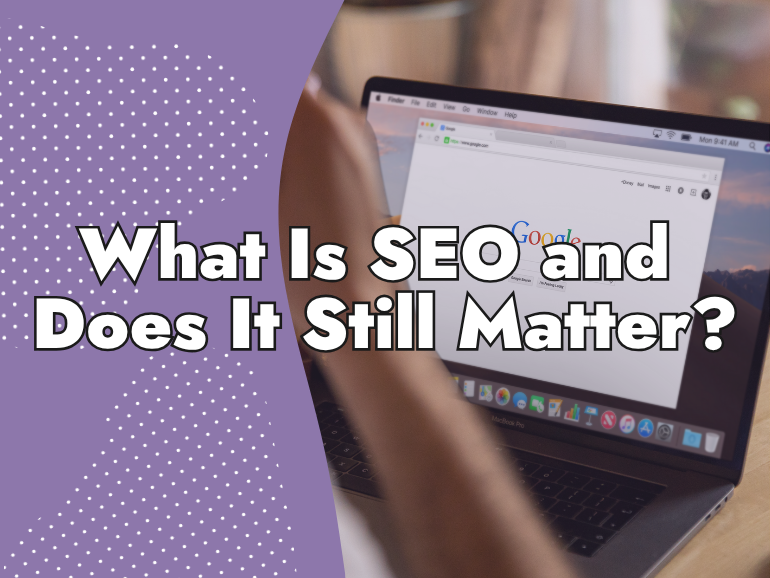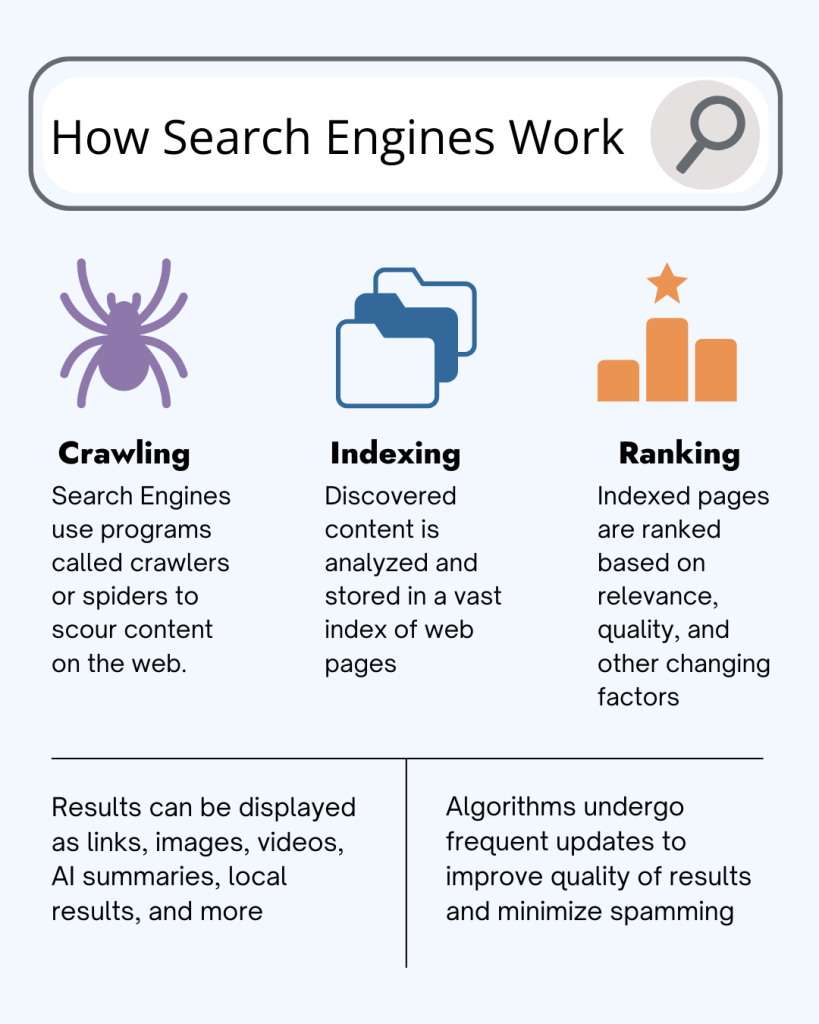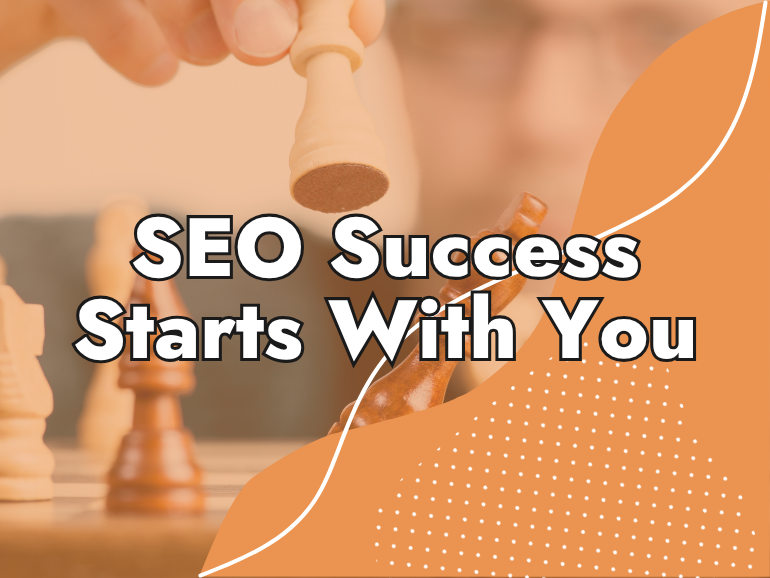What is SEO Marketing and How It Works
SEO can feel like a buzzword, but it’s one of the most powerful tools for growing your business online. This guide cuts through the jargon to explain what SEO really is, how it works, and why it matters — in plain language, with real value for business owners. If you’re trying to understand how SEO can support your goals, this guide offers clarity where others overwhelm.
Written by Keiran Griffiths
Last updated July 4, 2025 • First published May 24, 2022

Have you ever asked yourself, “Is SEO really that important?” or wondered if it can actually do what everyone says it does—like get your website to the top of Google or bring in more leads and customers?
You’re not alone. With so many buzzwords and bold claims in digital marketing, it’s easy to feel skeptical about where SEO fits in.
The truth is, when done right, SEO is one of the most reliable and cost-effective ways to grow your online presence and build long-term momentum for your business. In this article, we’ll break down exactly what SEO is, how it works, why it still matters more than ever in today’s digital landscape, and touch on the future of SEO.
What is SEO?
SEO stands for “search engine optimization”.
To simplify, SEO is the process of taking steps to help improve a website or piece of content, gain more visibility, and rank higher on search engines like Google, Bing, and Yahoo.
When a page has better visibility in search results, you’ll gain more attention and attract prospective clients and customers along with your already existing ones. Note, the higher the website is listed on search engines, the more people will see it.
It is best to always follow current SEO best practices to maintain the quality and relevance of your website. SEO best practices will also ensure your website is fast loading, easy to navigate and most importantly, user friendly.
LIKE WHAT YOU’RE READING?
If these articles are helpful,
imagine what our team
can do for you!


More Traffic. Leads. Business.
I want to show you how SEO can grow your business in ways you haven’t seen before.
More Traffic. Leads. Growth.

I want to show you how SEO can grow your business in ways you haven’t seen before.
Why is SEO Important?
SEO is a fundamental part of any digital marketing strategy, especially in today’s competitive online market. Search engines serve millions of users a day looking for specific questions and answers to their everyday needs and problems. The majority of search engine traffic goes to the top 5 results.
The most important SEO tasks have to do with the following, but are not limited to:
- Identifying what users are searching for that is related to your products and services
- Creating high quality and engaging content that matches the users’ search intent
- Following SEO best practices that best satisfy what the search engine algorithms are looking for
If you have a blog, website, or online store/business, SEO can help you get targeted, qualified traffic from search engines that can be used to grow your brand, increase sales, and promote business growth.
Why Are SEO Organic Search Results Important?
Organic search is a massive part of most businesses’ website performance and a critical component of acquiring a customer through a purchase or engagement.
Those that are ‘organic’ results are ones that are earned through effective SEO, not paid (i.e., not advertising or pay-per-click advertising), organic search results are based on the relevance to the user’s search, links, and domain authority on top of other organic factors. Simply, you can’t just pay for your page to rank higher in organic search results.
Developing a strong organic SEO strategy will not only provide many benefits but also provide key insights into your visitor traffic. Here are just a few of the reasons why it’s important:
- Higher-quality leads – people who find you through search are actively looking for what you offer.
- Very cost-effective marketing strategies – after the initial investment in SEO, ongoing organic traffic doesn’t have a cost per click.
- Long-Term ROI – a well-optimized page can generate traffic for months or even years, unlike paid search traffic that stops the moment you stop running ads.
- Provides important data to guide future efforts – SEO is based on data such as what your audience is searching for, which pages are performing best, what content leads to conversions, and more. This data can shape your future marketing, content and even product/service decisions. You gain real search behaviour and performance data to guide smarter strategies.
- It nurtures leads through the marketing funnel – because SEO is content-driven and user-focused, it naturally helps move people through the funnel
- Builds trust, authority and credibility – ranking well signals to users (and Google) that your site is credible and valuable.
- Drives consistent growth – SEO helps fill your funnel day after day, bringing in new customers and clients even when you’re not actively marketing.
How Do Search Engines Work?
Before diving into SEO further, let’s talk about how Search Engines work as SEO is all about getting better visibility in the Search Engines.
Search engines (like Google) are the ones that provide you with all the answers. They scour billions of pieces contents ultimately determining which is most likely to provide you with your final answer. By sifting through all available content on the Internet (via web pages, images, podcasts, videos, PDFs, etc.) via a process called ‘indexing’. Once indexed, Search Engines filter how well the content matches your query, referred to as ‘ranking’.
Search Engines are the directories of the Internet. Imagine the Internet as the largest library in the world. Now picture finding an image or article in this vast library. Unless the image has some defining terms to enter into the library directory, that picture is just a piece of paper floating around without categorization in the miscellaneous drawer. Now envision the billions of pages that users around the world have deposited onto the internet.
Search Engines were originally created to sort through all the information uploaded to the web daily. Search Engines use spiders to find and crawl the information on each new page. The Search Engines must then decipher how this information fits with every other page on the Internet. The page is then categorized and added to an index so that it is faster to recall and show in a Results page for a relevant search.

There is a big difference between what Search Engines actually show in results and all the possible results they could show that are stored in their results. In fact, Google uses more than 200 factors in its algorithm and is continually updating the formula to meet user demands. Most experts agree that Google makes between 500 and 600 changes to its search algorithm each year (Search Engine Land). This means that SEO is an ever-changing, ever-evolving process that needs to adhere to both current best practices and expected future best practices.
On top of the 500 – 600 changes to its algorithm per year, Google is also adjusting how it shows results. Search engines no longer just show ten blue links. Modern results often include images, videos, FAQs, map packs, and AI-generated summaries. Modern SEO helps position your content for all of these opportunities and ot just traditional rankings.
In 2024 and beyond, search engines like Google have started using advanced AI Overviews to summarize answers directly in search results, typically before showing links. This means your content not only needs to rank well but must also be clear, authoritative, and structured in a way that search engines can pull from it confidently for featured snippets and AI-generated summaries.
How Do Search Engines Like Google Rank Websites?
Before any website can be shown in Search Engine Result Pages (SERPs) the Search Engine must be able to:
- Find your website.
- Crawl (or spider) your website pages.
- Understand what information is on your website.
- Categorize each of your website pages in the indexes based on what it understands from your Source Code.
- Understand the intent of any Search Query by a person and display the pages in its index it believes are most relevant.
This means that your website must be easy for Search Engine spiders to find, to crawl all your pages, understand what is on your pages (including text and images) and be confident that your web page is the most relevant. Sound like a lot of work? This is where Search Engine Optimization comes in.
Why Quality and Quantity of SEO Organic Traffic Matters
The value of SEO has everything to do with the quantity and quality of organic traffic (unpaid Search Engine traffic):
Quality of organic traffic
At the end of the day, quality traffic is what accelerates business success. The quality of organic traffic is just as important as the traffic itself. Just think, when you’re searching for something and a product or business pops up that isn’t relevant to your inquiry, you’re likely to exit. This goes for the same as your website. Ensure your content is what your visitors are truly interested in. Google Analytics will sift through your engagement, conversion, and relevance metrics to show you where you can improve. Ensure your site, social media, etc. all clearly identify your objectives.
Quantity of organic traffic
This is the number of users who reach your site through organic search results. Search engines prioritize pages with high-quality content over those that are spammy or don’t provide valuable information. As we are aware, a search result that appears at the top of the SERP is more likely to get clicked on. The more visitors you attract to your site (quality and relevant ones), the more likely you are to see an increase in valuable conversions.
How Does SEO work?
When someone types a question into Google, Bing, or any search engine, they’re expecting the most relevant, helpful answer. Behind the scenes, search engines go through a three-step process to deliver that result: Crawling, Indexing, and Ranking. SEO works by optimizing your website for each of these stages so that your content can be discovered, stored, and displayed in search results.
1. Crawling – SEO Helps Search Engines Discover Your Content
Search engines use automated bots (called crawlers or spiders) to scan the web and discover new or updated pages. SEO helps with crawling by making your website:
- Fast-loading and mobile-friendly, so it’s easy for crawlers to access.
- Well-structured, with clear internal links so bots can move easily from page to page.
- Technically sound, using clean code, optimized URLs, and XML sitemaps.
Without proper crawling, your content might never be found, no matter how great it is.
2. Indexing – SEO Makes Your Pages Searchable
Once a crawler finds a page, the search engine decides whether to index it (store it in its searchable database). SEO ensures your content is index-worthy by:
- Using original, high-quality content that clearly communicates what your page is about.
- Avoiding duplicate content, broken links, or spammy practices that could lead to exclusion.
- Including clear metadata and structured data to help search engines understand the content.
If your pages aren’t indexed, they won’t show up in search results—period.
3. Ranking – SEO Makes You The Best Result
When someone searches for something, the engine pulls from its index and displays the most relevant, authoritative results first. This is where SEO has the biggest impact. Strong SEO helps your site rank higher by:
- Matching your content closely to user intent and search queries.
- Building authority through backlinks from reputable websites.
- Improving user experience with fast load times, mobile usability, and clear messaging.
The higher your page ranks, the more likely it is to be seen and clicked.
Key Elements That Make SEO Work for You
Now that you understand how SEO works, from crawling to indexing to ranking, let’s look at the practical ways you can help your website perform better in search results.
Search engines like Google aim to deliver the best possible experience and answer to every searcher. That means your website needs to be fast, easy to navigate, and filled with helpful, relevant content. Here are some of the core elements that contribute to SEO success:
- Keyword Research – Discovering the exact words and phrases your audience is searching for, then using them naturally throughout your content to improve visibility.
- Content – Well-written, relevant content that answers real questions, solves problems, and positions your brand as a helpful authority.
- Content Formats (Videos, Blogs, Infographics, Podcasts, Listicles) – Using a variety of engaging formats to meet different learning styles and keep your audience interested.
- Header Tags & Meta Descriptions – Clear, structured elements that help search engines understand your page content and encourage users to click through from search results.
- Website Design & Development – A user-friendly, mobile-responsive site that makes it easy for both visitors and search engines to navigate and engage with your content.
- Page Speed – Optimizing how quickly your site loads to reduce bounce rates, improve user experience, and support stronger search rankings.
- Link Building (including Citations) – Earning backlinks from credible websites and local directories to build trust and improve your authority in the eyes of search engines.
- EEAT (Experience, Expertise, Authoritativeness, Trustworthiness) – Google increasingly favours content that demonstrates real-world experience and transparent authorship.
- Structured Data/Schema Markup – Helps search engines better understand your content and increases your chances of rich results (star ratings, FAQs, events, products, etc.)
- Search Intent Alignment – Creating content that matches what the searcher is really looking for—whether they want to learn, compare, buy, or find something specific.
- AI-Optimized Content Structure – Clear, concise content using headings, bullet points, and natural language so it’s easy for AI tools and search engines to pull into featured snippets or summaries.
- Voice Search Optimization – Writing in a natural, conversational tone and including question-based headings to better align with how people speak their searches.
- Mobile UX & Core Web Vitals – Ensuring your site loads quickly, looks great on mobile, and provides a smooth user experience by meeting Google’s performance benchmarks.
- Content Freshness – Keeping your content up to date with new stats, insights, or sections to stay relevant and competitive in search rankings.
- AI vs. Human Balance – Blending AI tools with real human insight, original perspective, and hands-on experience to create content that stands out and earns trust.
- Topical Authority & Content Clusters – A strategy of building multiple related pieces of content around a main topic to show depth and expertise in a specific area.
All of these pieces work together to make your content more discoverable, relevant, and trustworthy. Each year, industry experts like Search Engine Land publish updated SEO “Periodic Tables” outlining the most influential ranking factors. Keeping up with changes is key to long-term SEO success.

How It All Comes Together: The Pillars of SEO
Now that we’ve covered the key elements that make SEO work (like content, speed, structure, and authority) it’s helpful to understand how these pieces fit into the bigger picture.
Most traditional SEO strategies can be grouped into three core categories, often referred to as the pillars of SEO:
- On-page SEO: involves any optimizations on your website including optimizing individual webpages to help the perform better in the ranking and attract targeted traffic.
- Off-page SEO: refers to SEO tactics that are not part of the physical website that impacts your ratings within search engine results. This practice helps strengthen your relationship with other sites and builds your online reputation (the most common way is via backlinks).
- Technical SEO: refers to both website and server SEO, which will help the search engine spiders to more effectively crawl and properly index the site content (helping to improve organic rankings).

What Is a Good SEO Strategy and Process to Get Better Visibility?
At 1st on the List, we’ve spent over 25 years refining an SEO process that delivers long-term growth while adapting to the ever-changing world of search. A good SEO strategy isn’t just about quick wins. It’s about building a strong foundation that evolves alongside new algorithms, technologies, and user behaviors. From core technical optimizations to emerging strategies like structured data (schema) and generative engine optimization (GEO), our process is built to keep your website accessible to search engines and highly relevant to your audience—today and into the future.
1. Technical Audit or Site Analysis
Taking stock of the current state of any website with a Technical SEO Audit provides a good strategy for moving forward and determining what needs to be fixed to make it easier for the Search Engines to access and crawl your website.
- Review the site to make sure the Server and Hosting are set up properly, to make it as easy as possible for the Search Engines to access any page on your site at any time.
- Review the website for duplicate content, spam, slow load times, broken links, and other things the Search Engines will demerit your website for.
2. SEO Keyword Research and Planning
A large part of Search Engine Optimization is making sure that the words people are using to search for a company like yours are visible on your website for the Search Engines to read. Keyword research provides the basis for optimizing the content on your website and seeks to discover:
- What phrases people are using to search for your company? (These are your “keywords”)
- What SEO Keywords are the most popular (search volume), have the fewest competing pages and are most relevant to the content presented?
- What phrases are most attainable for your website and will attract the most qualified traffic?
3. SEO Content Optimization and Creation
Once the research stages of the Site Analysis and Keyword Research are completed it is time to start optimizing the content on the website. This SEO work includes but is not limited to:
- Proper page source code
- Internal link structure
- Meta Data
- Alt Tags
- Page headings and sub-headings
- Sitemap creation
- Body text content that supports the keywords searcher’s use.
A site must attract visitors and it must hold the visitor’s attention. Google uses engagement metrics as one of its ranking factors. The more people who visit your website and stay on it for a long time and look at a number of pages, the more often the Search Engine will show the site in Search Results.
Content optimization focuses on accessibility, reliability, readability, currency, credibility, and more as these affect site rankings. Content optimization also focuses on giving visitors the exact information they are looking for, plus anticipates what additional information the visitor will need to complete a conversion, such as purchasing a product or signing up for a consultation.
4. Website Analytics
Once most of the initial grunt work is complete to bring a website up to Search Engine standards the best way to increase value is to monitor its progress and growth. This stage is called “Analytics” and includes analytics & reporting plus:
- Monitoring visitor traffic to the site over a set time period
- Tracking and understanding visitor motivations
- Tracking where and how visitors use the website
- Tracking and measuring sales conversions
Often Analytics can give additional insights to go and tweak items from the Technical SEO Audit, Keyword Research and Content Optimization stages.
5. Ongoing SEO Maintenance
If you think SEO is a one-time task you are wrong. SEO is always ongoing as the Search Engines like to see fresh and new content on your website. With more than 500 websites created every minute and with your competitors working on their SEO strategy you can’t afford to just sit back. Ongoing website optimization and maintenance keep web content current, relevant and maintained to meet the changes that the search engine algorithms make, changes in HTML standards and what visitor searching habits indicate.
Search Engine Optimization has changed drastically in our 25 years of experience. However, our general process for optimizing websites has remained stable and is able to achieve lasting results for clients.
General SEO FAQ
Have More Questions for Our SEO Specialists?
Are you still needing help with your SEO? Do you have questions about your current SEO campaign, management, strategy, progress, reports, or website in general? Call our SEO experts at 1-888-262-6687 or send us a message to chat. We’re ready to help give insight into your SEO status to identify areas for growth and improvement.
Keiran Griffiths
Keiran Griffiths is the President & Managing Director at 1st on the List. He works exclusively out of the Abbotsford head office and has extensive experience helping small and big brands grow their business. His background is in restaurant and hospitality management as well as business development (he started his own property management company in 2014). Up for any challenge, Keiran works with clients to assess their budget and investment capabilities and come up with a marketing solution that will earn them the biggest bang for their buck.
Don’t miss out – get newest posts straight to your inbox!
OTHER ARTICLES WE THINK YOU’LL ENJOY
Partner With Us. Get More Leads.
Stop trying to do it all on your own – reach out to our team and we can discuss marketing strategies that are best suited for your business!
[NO HASSLE, NO PRESSURE, NO WORRIES – JUST MEANINGFUL INSIGHTS]








